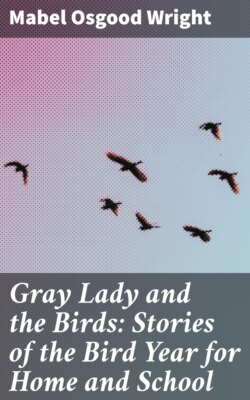Читать книгу Gray Lady and the Birds: Stories of the Bird Year for Home and School - Mabel Osgood Wright - Страница 6
На сайте Литреса книга снята с продажи.
The Bird
ОглавлениеTable of Contents
“Who can tell me exactly what a bird is? You all may think you know, but can you put it in words?”
“A bird isn’t a plant; it is an animal,” said Tommy Todd.
“Yes, but a cat is an animal, and a snake, and a horse; and we are animals ourselves.”
“A bird is a flying animal,” returned Sarah.
“Very true, but so is a bat, and, as you know, a bat has fur and looks very like a mouse, and a bird does not.
“Ah, you give it up. Very well, listen and remember. A bird is the only animal which has feathers! With his hollow bones filled with buoyant, warm air, and covered with these strong pinions, he rows through the air, as we row a boat through the water with the oars, balancing himself with these wings, also steering himself with them and with his tail made of stiff feathers and shaped to his particular need, while with small feathers laid close, overlapping each other like shingles, and bedded on an under-coat of down, he is clothed and protected from heat, cold, and wet.
“The eye of the bird is different from ours, for it magnifies and makes objects appear much larger to it than they do to us. Also, while with other animals each group has practically the same kind of feet or beaks, birds have these two features built on widely different plans, so that when you have learned to know the common birds by name and are really studying bird-life, you will find that you must be guided to the orders in which they belong often by their beaks and feet.
“Barnyard Ducks, as you know, have webbed toes for swimming, and flat bills to aid them in shovelling their natural food from the mud.
“Birds of prey, like the Hawks and Owls, have strong hooked beaks and powerful talons or claws, for seizing and tearing the small animals upon which they feed.
“The Woodpeckers (all but one) have two front and two hind toes; these help them grasp the tree bark firmly as they rest, while they have strong-cutting, chisel-like beaks, which they also use for tapping or drumming their rolling love-songs.
CHICKADEE
“While the insect-eating song-birds have more or less slender bills and four toes, three in front and one behind, for perching crosswise on small branches, the seed-eating songsters, such as Sparrows, have similar feet, but short, stout, cone-shaped bills for cracking seeds and small nuts.
“By this you can see that in spite of the fact that all birds wear feathers, and have wings, a tail, beak, and a pair of legs, they may still be very different from each other.
“A Turkey Gobbler doesn’t look much like a Robin, nor a Goose like a Swallow, yet they are all four birds! They all four bring forth their young from eggs; but the little Turkeys and Goslings are covered with feathers when they peep out of the shell and are able to walk, while the young Robins and Swallows are at first blind, naked, and helpless; so here again you can see that there is something special to be learned about every bird that flies or swims.”
“Chickadee-dee-dee! Can’t you tell them something about me?” said this dear little bird, flitting about one of the open windows and clinging upside down to the blind slats that were bare of paint, like either a Woodpecker, or, as Tommy Todd remarked, “the man in the circus.”
“The little bird peeping in the window and calling his name reminds me of a pretty poem about him,” said Gray Lady. “I will repeat it to you and write it on the board so that you can copy it in your books, and then some of you may like to learn it to surprise Miss Wilde on another rainy Friday.”
